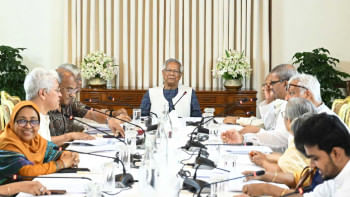Gas crisis may linger
US company Chevron has found no additional gas in the eco-sensitive Lawachhara forest under its existing Moulavibazar gas field.
This means an expected solution to the gas crisis by next year with additional supplies from three of Chevron's gas fields has become uncertain.
Failing to strike additional gas in Moulavibazar, Chevron has revised its two-year-old proposal for supplying another 940 million cubic feet a day (mmcfd) gas from 2013 and now says it will supply 500 mmcfd.
Chevron drilled two wells in Moulavibazar late last year hoping to find more gas reserves but both of these turned dry, said sources in Petrobangla and Chevron.
The government however remains optimistic about resolving the crisis in two years.
According to Energy Secretary Mezbah Uddin, there were prospects of hitting new gas at several sites in the gas fields owned by the national companies in greater Sylhet region. Moreover, the unutilised Tengratila gas field of Niko might also come into operation.
Two years back, based on a three-dimensional survey in three fields --Moulavibazar, Bibiyana and Jalalabad -- Chevron proposed to increase gas production by 940 mmcfd saying that these had additional gas reserves.
This gas would be enough to meet the on-going crisis which is affecting power generation to home consumption. It would also provide a respite for a few years for the country by ending its increasing dependency on imported oil for power generation.
Chevron is already producing 920 mmcfd from the Bibiyana, Moulavibazar and Jalalabad fields.
Amid resistance from a pressure group, Chevron conducted seismic survey in the eco-sensitive Moulavibazar area three years back.
Based on its findings, Chevron late last year started drilling two wells from the edge of Lawachhara forest so that the environment remains unaffected. But in the end, it found no new gas reserve.
But after the Moulavibazar failure, Chevron is banking on increasing production from the Bibiyana gas field where six new wells are now being drilled. It will also supply some additional gas from the Jalalabad field.
To get this gas, the government has recently awarded a Tk 1,650 crore contract for setting up a 36-inch diameter 137 km-long pipeline between Sylhet and Dhanua, which is large enough to transmit 1,000 mmcfd.
The energy secretary feels that the large new pipeline would not go unutilised despite the failure to get new gas reserves in Moulavibazar.
The new pipeline project was taken up considering not just the Chevron gas fields, he said. “We have to think ahead. Bapex is conducting three-dimensional studies in our old Rashidpur-Habiganj fields and it is expected that more gas will flow from Sylhet.”
Mezbah Uddin noted that the stalemate over Niko-Bapex's Chhatak East (Tengratila) gas field would be resolved soon and it would give another additional supply.
The Tengratila field that blew up twice due to Niko's inefficient handling in 2005 apparently has around one trillion cubic feet (tcf) gas reserve. But due to legal complications arising out of Niko's controversial deal with Bapex as well as compensation claims of the government from Niko for the two blowouts, the field has not yet started commercial operation.
Besides, Bapex is now set to start drilling in a major new site named Sunetra in Sunamganj-Netrokona region. If successful, the discovered gas would be linked to the new 36-inch pipeline.
“If we had a new gas pipeline, the present crisis would not have been so acute as we already had some unutilised gas available in some fields,” said the energy secretary.
The pipeline is being constructed in several segments so that the contractors can complete the job by late 2013 or early 2014.
Referring to Chevron's initial assessment based on a three-dimensional study, the energy secretary said the actual reserve of a gas field could be assessed only after drilling wells there.
Chevron's estimate on the basis of three-dimensional survey could naturally change after drilling of wells. While the new wells in Moulavibazar were found dry, there were still high prospects of additional gas in Bibiyana, he said.
Chevron on the other hand told The Daily Star that in 2011 Petrobangla asked it to increase its production by 500 mmcfd. "We are working hard to respond to this challenge."
It went on, “Our fields have additional production capacity, which could be realised if the present pipeline constraint issues are addressed. We are encouraged to see that plans for the Jalalabad-Bibiyana-Dhanua pipeline are being implemented. We anticipate that this pipeline will increase the supply of gas to the national grid.”.
Meanwhile, the gas crisis is worsening as the country's lone off-shore Sangu gas field has reached its dying stage, barely producing seven-eight mmcfd now from a whopping 150 mmcfd a decade back.
Sangu's Australian operator Santos drilled a new well in South Sangu hoping to strike a small reserve. But it turned out dry. The company is now drilling another well in Sangu.

 For all latest news, follow The Daily Star's Google News channel.
For all latest news, follow The Daily Star's Google News channel. 



Comments